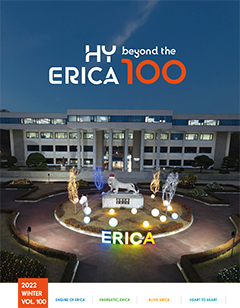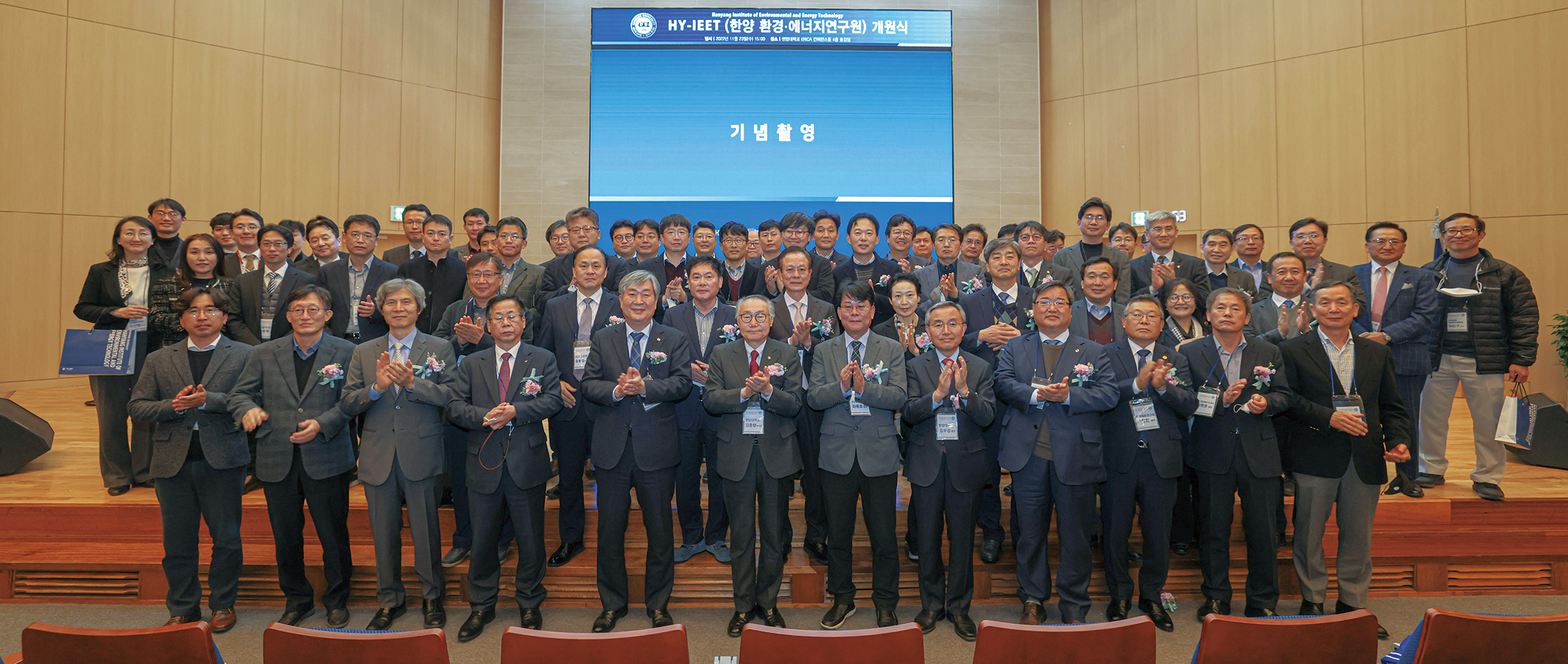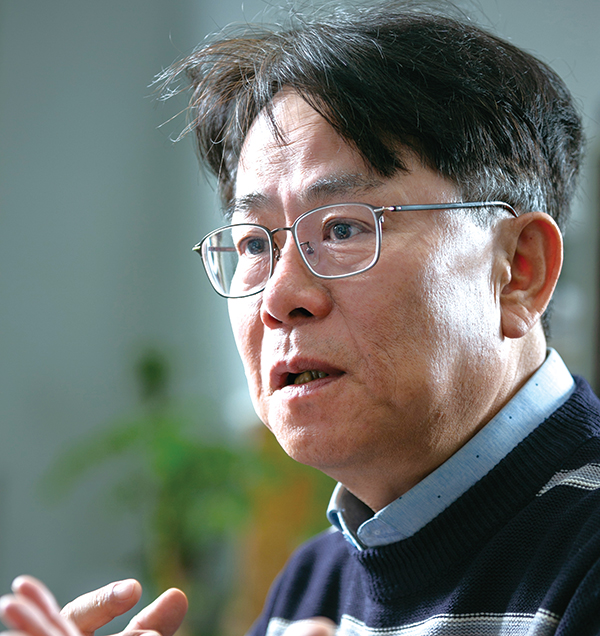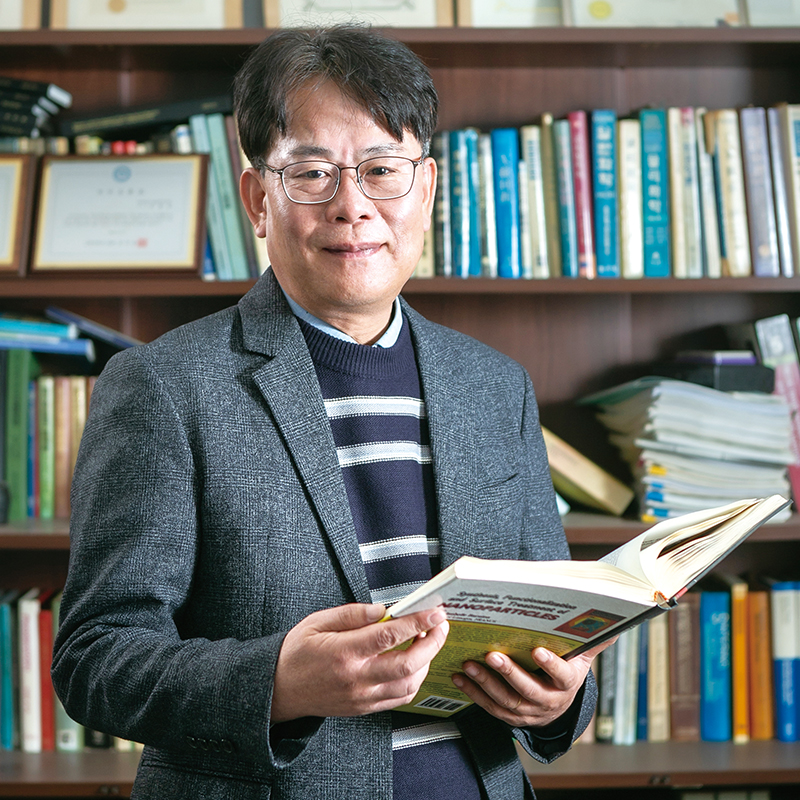Contents
Vol. 100

Cover Story ERICA 본관에 연말을 알리는 찬란한 빛이 내려 앉았습니다. 올 한 해 ERICA는 혁신과 성장, 끝없는 도전으로 달려왔습니다. 그 모든 성과는 온 힘을 다해 달려온 대학 구성원의 노력이 빚은 값진 결실입니다. 100권의 HY ERICA에는 수고를 아끼지 않는 대학 구성원의 모습, 그 노력의 과정이 고스란히 담겨있습니다. 더 나은 내일을 꿈꾸는 비전의 사람이 모인 이곳, ERICA의 이야기는 앞으로도 계속될 것입니다.
- ENGINE OF ERICA
- the 100th, HY ERICA ERICA의 모든 날, 모든 순간
- Now, ERICA 신안산선 한양대역 출입구 신설 · ERICA 미래 성장 기반 확보 원호식 캠퍼스혁신파크사업단장
- Focus on Research 환경 · 에너지 기술혁신 시대를 맞이하는 새로운 연구 플랫폼 구축 한양 환경 · 에너지연구원 개원
- ERICA Impact 학술적 성과, 그 이상의 결과에 도달하는 연구자의 도전 정신 컴퓨터네트워크 연구실
- ENERGETIC, ERICA
- LINC+&YOU LINC 3.0 축적된 인프라를 토대로 공유하며 확산한다 기업지원 프로그램
- Start Line 영상 콘텐츠 스타트업으로 살아가는 방법 크레용유니버스 윤보석 대표, 레이븐어스 정지용 대표
- ERICA Pride 그린수소 생산용 3차원 구조의 저비용 촉매 제시 이승현(화학분자공학과) 교수
- Take Classes 최첨단 K · 방위산업을 이끌기 위해 ERICA와 LIG넥스원이 손잡았다 지능정보융합공학과 신설
- ALIVE, ERICA
- Campus Finder 도전의 DNA, 모교를 향한 사랑, Opening Ceremony 노상일 HOLMZ 개관식
- ERICA People Ⅰ 미래에 실질적 변화를 일으킬 연구의 힘과 가능성 문효방(해양융합공학과) 교수
- ERICA People Ⅱ 남을 즐겁게 할 수 있다는 가치 있고 고귀한 일 영화감독 박규태(신문방송학과 91) 동문
- ERICA People Ⅲ 음악을 통해 대중과 교감하는 뮤지션으로 성장한다 정광수(실용음악학과 17), 조남준, 최아임(실용음악학과 18) 학생
- Special Lecture 기후위기, 인류가 지금 고민해야 할 유일한 화두 예상욱(해양융합공학과) 교수

Hanyang Institute of Environmental and Energy Technology
The institute will spearhead basic and convergence research by conducting core environmental and energy research. It will do so to pursue convergence research with a focus on application by establishing infrastructure and core research groups. The institute will also promote research on the lifecycle of environmental and energy technologies. Moving forward, the institute will lead the creation of a convergence cluster through industry-university cooperation activities that will include technology transfers and investment by developing core technologies in the environmental and energy sector, and startups created by faculty members.
Incorporating ERICA’s competitiveness into keywords of the environmental and energy sector
The environment and energy are extremely hot topics these days and particularly in the industrial sector. ERICA is thus taking a major leap forward to spearhead research and create an ideal environment for such research that befits the current transition to ESG, witnessed across all industries, along with pursuing the goal to achieve carbon neutrality by 2050. At the center of these efforts is the Hanyang Institute of Environmental and Energy Technology (HY-IEET) which consists of six new centers including: △the Advanced Semiconductor Packaging Research Center; △the Applied Research Center for Electro-Fusion Technology (EFT Center); △the Advanced Thermal System Research Center; △the Carbon Neutral Energy Infrastructure Research Center; △the Sustainable Energy Technology Research Center; and the △Environmental and Biological Research Center. HY-IEET will be at the forefront of creating detailed solutions by having each research center conduct convergence research in their respective fields.
“Developing technologies in the environmental and energy sector is a task that should be accomplished for future generations. As environmental and energy technologies are highly relevant across the entire area of science and engineering, development of thermal technologies has become the main keyword in environment and energy research.”
President Woo-seung Kim, Vice President Han-seung Lee, members of the Academic Affairs Office, and directors of the six research centers held strategy discussion meetings for close to six months before the establishment of the HY-IEET. As a result, ERICA began to focus on the topic of heat, which is something that is often overlooked by researchers in Korea despite its far-reaching influence in the industry.
“Heat affects our lives in numerous ways including in global warming and its significant impact on the environment, energy efficiency matters related to construction and power transmission ─ and small impacts, including a decrease in efficiency caused by the process of energy transmission and conversion to heat.”
Accordingly, HY-IEET and the six new research centers have established a mid-term goal to create a research group of talented individuals and infrastructure to lead the basic and convergence technology sector based on core technologies related to heat. For semiconductor applications, the Advanced Semiconductor Packaging Research Center conducts research on thermal design·material technologies at the packaging level and semiconductor design technologies with low power-consumption and high efficiency, which has a significant impact on the performance of semiconductors. The Applied Research Center for Electro-Fusion Technology (EFT Center) conducts research on high-efficiency power transmission technologies for smart grids, and the Advanced Thermal System Research Center conducts research on cutting-edge thermal fluid systems in the areas of home appliance and machinery, plus energy conversion and recovery technologies. The goals of the Carbon Neutral Energy Infrastructure Research Center are to save energy through insulation and heat-generation technologies and develop zero-energy building design·material technologies. The Sustainable Energy Technology Research Center, which conducts research on sustainable energy technology, aims to conduct studies on eco-friendly materials, sustainable energy material technologies that reduce emissions, and sensors that measure thermal energy (IR band) and detect harmful substances.

Synergy effects driven by sustainable future-oriented convergence research
For Korea, a country that largely depends on exports, carbon neutrality and development of eco-friendly energy sources are no longer an option. Establishing measures to improve the fundamentals fast has become a pressing issue as ESG performance indicators are gaining increasing importance around the world.
“As a manufacturing powerhouse, Korea should achieve industrial development by efficiently using and managing its energy sources. Thermal management, and cooperation and convergence among different fields, including mechanical engineering, electrical engineering, architectural engineering, materials engineering, and chemical engineering, are critical for achieving efficient use and management of energy sources.”
There is a lot of research on the environment and energy as they are topics of national interest. HY-IEET has garnered a lot of interest for its unique research capabilities from when it was first established, from the ability to define tasks based on critical environmental and energy issues and convergence research conducted to achieve those tasks. Laying the groundwork for successful convergence research is also extremely important. President Choa emphasized the importance of sustainable, open-convergence, and future-oriented research for strengthening research capabilities and resources dedicated to establishing physical and intellectual infrastructure. HY-IEET renovated a lecture room to teach practical English to create an ideal environment for intensive research and plans to use the more than 100 types of equipment that ERICA already had acquired. These are in addition to introducing more than 10 types of high-end equipment related to thermal energy in order to become a KOLAS-accredited institute. The institute will take action to further strengthen industry-academia cooperation including issuing accredited certificates to companies that take part in research projects, providing researchers with research equipment and technical advice, and providing training sessions for employees working for the organizations. HY-IEET is making various efforts to further solidify its base for industry-academia cooperation by supporting commercialization through joint research with organizations and mutually fostering of talented individuals. Establishing an appropriate base for research is necessary to achieve the vision set by the researchers.
“We plan to become self-reliant by gaining status as a KOLAS accredited institute whereby we will introduce high-end equipment to test thermal properties, providing outstanding students in graduate school military exemption benefits, initiating projects to establish large-scale infrastructure for organizations, and conducting joint research with over 100 organizations. We believe these efforts will help Hanyang University researchers further develop their world-class capabilities to contribute to the advancement of the society and the industry.”
President Yong-ho Choa has held various positions such as the president of the Industry-Academia Cooperation Foundation and president of the Academic Research Center, has invested much of his own time and effort in establishing HY-IEET, based on a clear vision for the world and the role of universities. He explained, “I believe that the role of universities is to produce the experts that the society needs. Hands-on skills training and research are crucial for nurturing such individuals. From my perspective, convergence research wouldn’t exist without basic research. This is why our research institute will continue to spare no effort or resources in basic convergence research. What I want is to use the foundation we have built to further promote industry-university cooperation and contribute to the growth of the society and related companies.”
HY-IEET’s research is conducted based on a forward-thinking approach that focuses on problems that frequently come up in the environment and energy sector and solutions, rather than simply resolving current issues. When successful, convergence research will eventually lead to the advancement of the industry and will become an important asset that better prepares us for the future. The outcome of Hanyang ERICA’s genuine and sincere research spirit and the research capacity upgraded to the next level through the establishment of the institute is something to look forward to.
Professor Yong-ho Choa
First president of the Hanyang Institute of Environmental and Energy Technology
(Professor of the Department of Materials Science and Chemical Engineering)
President Yong-ho Choa and the Functional Nanostructured Materials Research Lab conduct research on sensors using nanowire, thermal management materials for electronic components, nanostructured materials with thermoelectric and magnetic properties, and eco-friendly nanostructured materials that remove carbon dioxide and harmful substances. He became a member of the National Academy of Engineering of Korea in 2020 and the 23rd President of the Korean Powder Metallurgy & Materials Institute. He has published over 300 research papers in SCI by conducting a variety of research to overcome the limitations of existing materials, registered more than 120 patents, and completed 12 technology transfers through industry-university cooperation.








